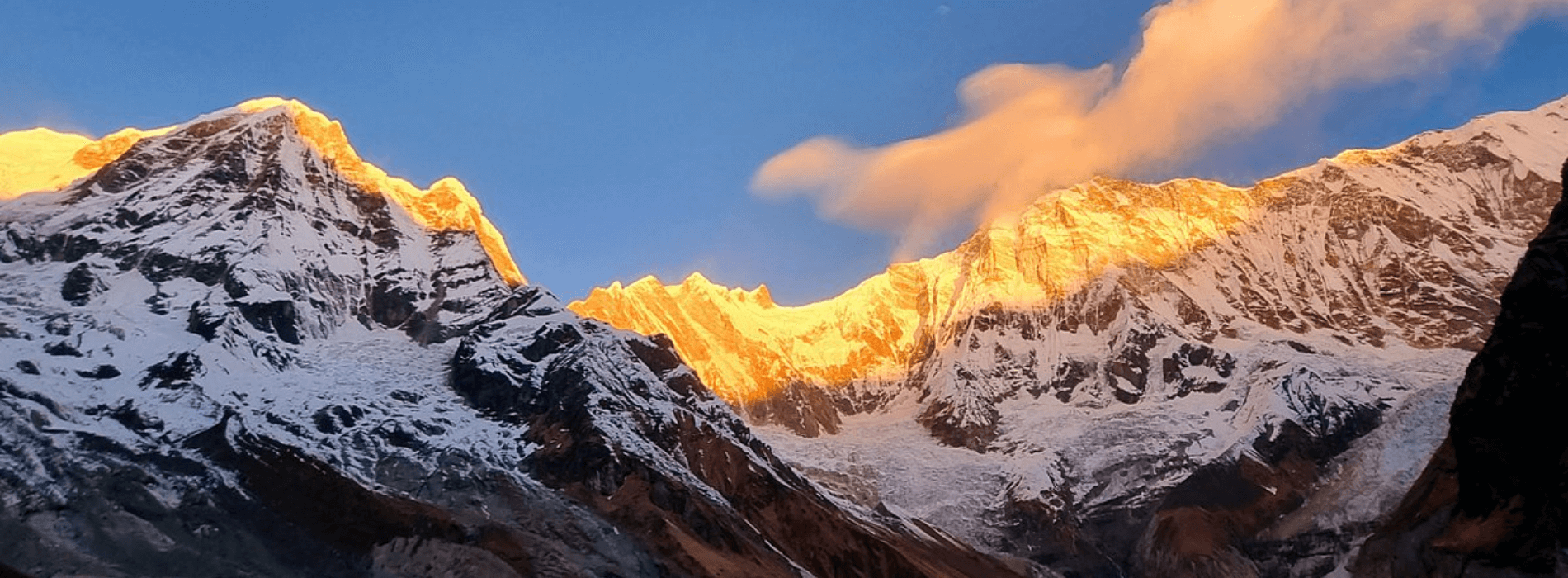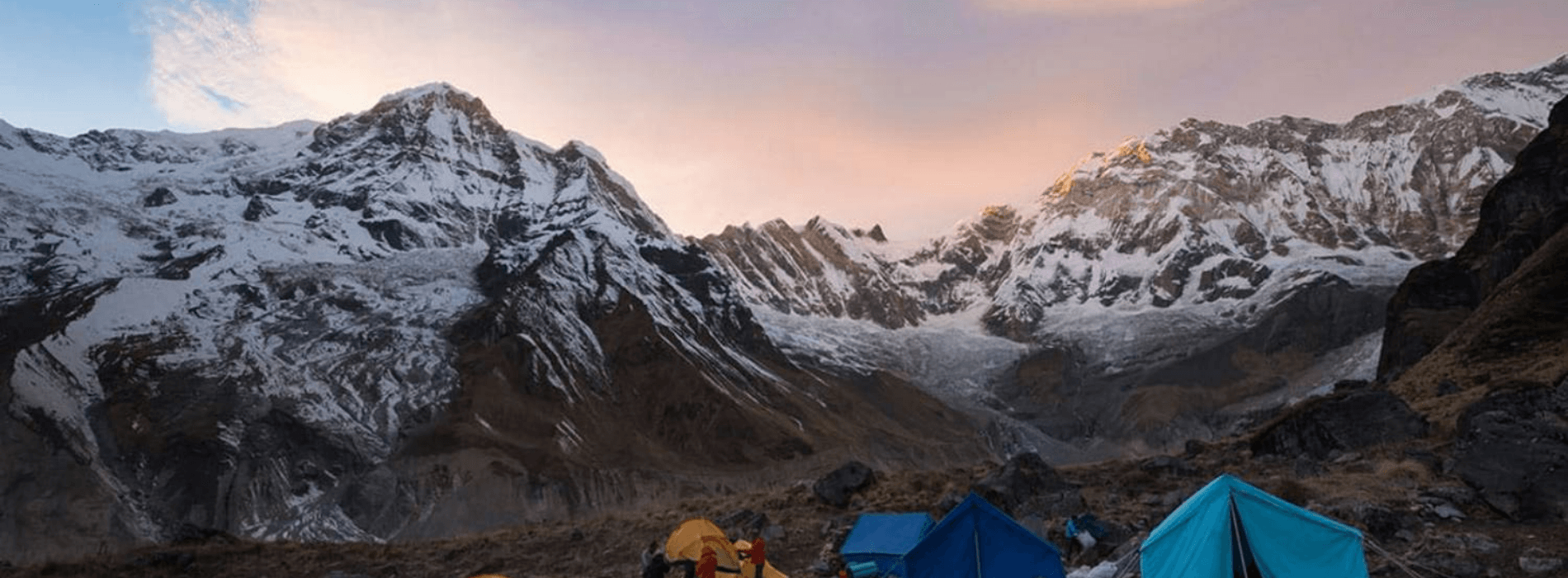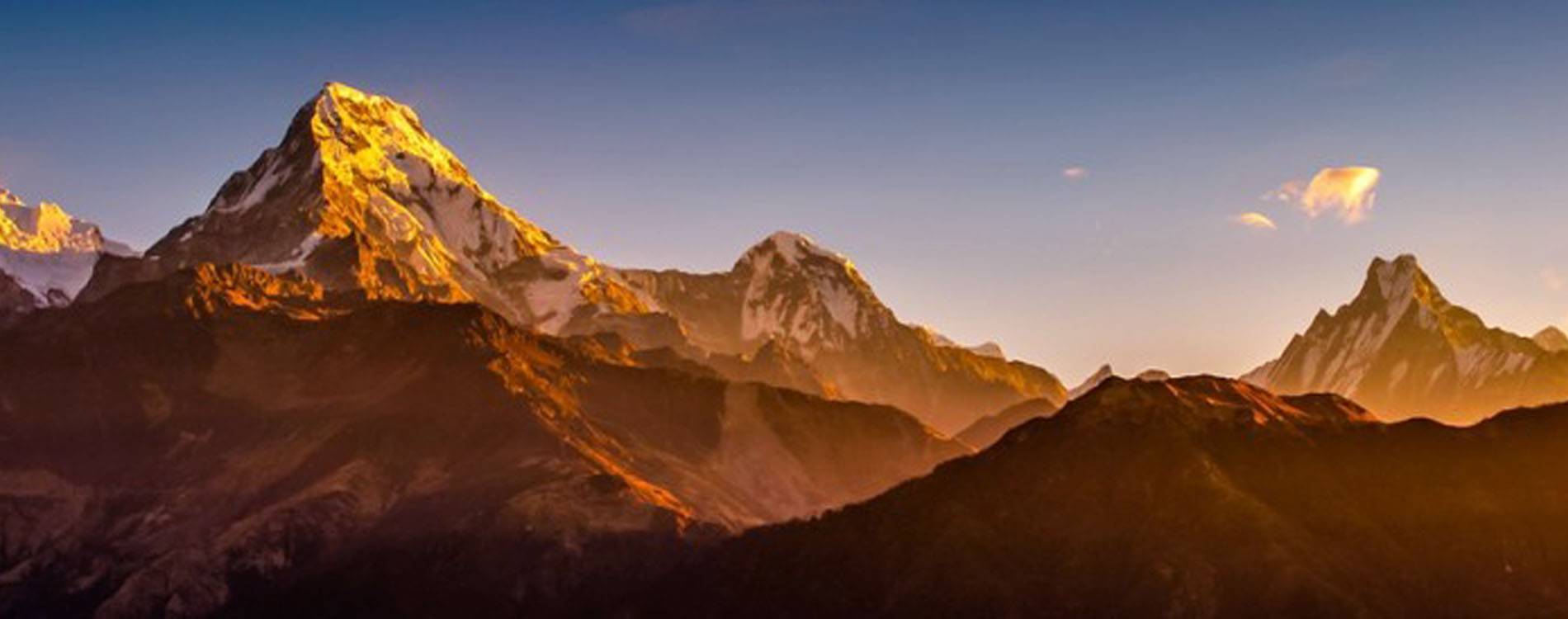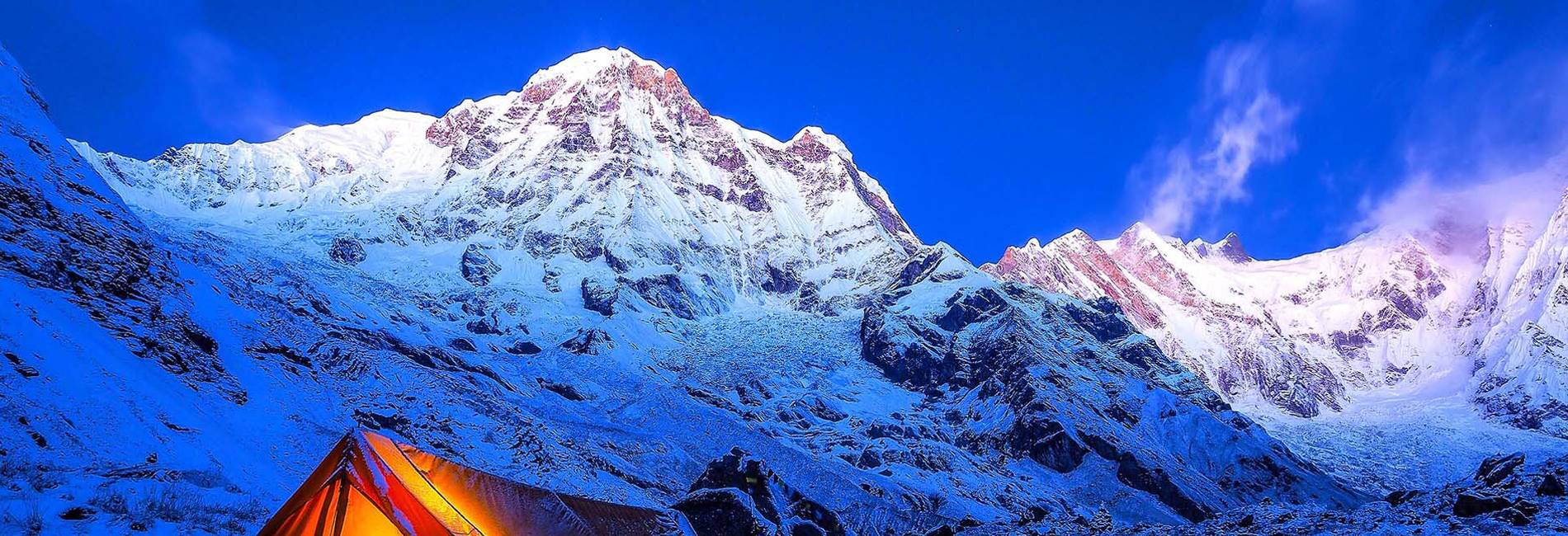26th August, 2025

Oct 16, 2023
Annapurna Base Camp Trek In January
- ABC Trek In January Highlights
- Is it a Good Time to Trek to Annapurna Base Camp in January?
- Annapurna Base Camp Trek January: Weather, Climate, and Temperature
- Can I Do Annapurna Base Camp Trek in January?
- How Safe is Trekking to ABC in January?
- Why January Annapurna Base Camp Trek?
- Can We Do Annapurna Base Camp Trek Without Guide?
- Can I Trek to ABC Solo?
- How Can I Get to Annapurna Base Camp?
- Can I Do It In 7 Days?
- What Should I Pack For January Trek to ABC?
- What Kind of Permit Required for ABC?
- What Should I Pack for ABC Trek In January?
- Conclusion
- Annapurna Base Camp Trekking packages
Trekking to Annapurna Base Camp (ABC) in January offers a unique and challenging experience amidst Nepal's winter season. January is characterized by cold temperatures and clear skies, creating stunning vistas of snow-covered peaks and pristine landscapes along the trekking route.
Weather in January at lower altitudes, such as Pokhara (the starting point for the trek), ranges from 8°C to 20°C (46°F to 68°F) during the day, while temperatures drop significantly as you ascend higher towards ABC at 4,130 meters (13,549 feet). At higher elevations, temperatures can plummet well below freezing, especially during early mornings and nights, necessitating proper cold-weather gear including insulated jackets, thermal layers, gloves, hats, and warm sleeping bags.

ANNAPURNA BASE CAMP TREK 10 DAYS
This 10 days Annapurna Base Camp (ABC) trek brings you into the heart of Nepal's Himalayas from the very being of the hike. With so many snow-capped peaks on the show, it is no surprise this one-week-...
Despite the cold, January offers the advantage of fewer trekkers on the trail compared to peak seasons, providing a quieter and more serene trekking experience. The trail itself is typically well-marked and accessible, though occasional snowfall can make certain sections more challenging. Trekking through snow-covered forests, picturesque villages, and alpine meadows adorned with frost offers a magical ambiance, perfect for photography enthusiasts.
Cultural encounters with local Gurung and Magar communities add to the trek's charm, allowing trekkers to experience traditional hospitality and customs amidst the winter season. Teahouses along the route remain open, offering warm meals and shelter, crucial for staying comfortable and rejuvenated during the trek.
In conclusion, while trekking to Annapurna Base Camp in January requires preparation for cold weather and potential snowfall, it rewards adventurers with breathtaking winter landscapes, cultural experiences, and a memorable journey through one of Nepal's most iconic trekking routes.

ANNAPURNA BASE CAMP TREK 6 DAYS
The 6 days Annapurna Base Camp Trek is an ideal adventure for those people who have a tight schedule but still want to experience the amazing landscape and the fascinating lifestyles of the Gurung cul...
ABC Trek In January Highlights
Trekking to Annapurna Base Camp (ABC) in January offers a serene and majestic experience amidst Nepal's winter wonderland. The trek takes you through snow-covered landscapes, providing stunning views of the Annapurna mountain range and neighboring peaks like Machapuchare. The trail, usually quieter in January, allows for a more peaceful journey through pristine forests, traditional villages, and alpine meadows blanketed in snow. Cultural encounters with local communities, such as the Gurung and Magar people, offer insights into their traditions and hospitality, enhanced by the festive winter atmosphere.
Is it a Good Time to Trek to Annapurna Base Camp in January?
January can be a rewarding time to trek to Annapurna Base Camp for those seeking a quieter and more contemplative trekking experience. While temperatures are cold, ranging from mild at lower elevations to freezing at higher altitudes, the clear skies and snowy landscapes create a picturesque setting. The reduced number of trekkers on the trail allows for a more intimate connection with nature and the local culture. However, trekkers should be prepared for colder conditions and potential snowfall, which can enhance the trek's beauty but also require careful planning and adequate cold-weather gear.

GHOREPANI POON HILL ABC TREK
This is a classic trek, visiting Ghorepani (2874m), Poon Hill (3210m) & Annapurna Base Camp (4130m) - all within the Annapurna Conservation Area.Annapurna is a Sanskrit name which literally means...
Annapurna Base Camp Trek January: Weather, Climate, and Temperature
Trekking to Annapurna Base Camp in January means embracing Nepal's winter climate. Daytime temperatures at lower elevations (around 1,000 to 2,000 meters) range from 8°C to 20°C (46°F to 68°F), while temperatures drop significantly as you ascend higher towards ABC at 4,130 meters (13,549 feet). At higher altitudes, temperatures can fall well below freezing, especially during the night and early mornings.
January typically experiences clear skies with occasional snowfall, creating a postcard-worthy winter wonderland along the trekking route. Trekkers should be equipped with warm clothing, including insulated jackets, thermal layers, gloves, hats, and a warm sleeping bag suitable for sub-zero temperatures. Proper footwear with good traction is essential for navigating potentially icy or snowy trails.
Despite the cold, January offers the advantage of quieter trails and breathtaking views of snow-covered peaks. Trekkers can enjoy the tranquility of the Himalayan landscapes and capture stunning photographs amidst the crisp winter air. Teahouses along the route provide essential services, including warm meals and accommodation, ensuring trekkers' comfort and safety in the winter conditions.
Can I Do Annapurna Base Camp Trek in January?
Trekking to Annapurna Base Camp in January is possible with proper preparation and an understanding of the winter conditions in the Himalayas. While colder temperatures and potential snowfall present challenges, the trek offers unique rewards for adventurous trekkers. It's essential to be physically fit, have prior trekking experience, and carry adequate cold-weather gear, including insulated clothing, waterproof layers, gloves, and a warm sleeping bag rated for sub-zero temperatures.
Solo trekking is feasible but requires confidence in navigation and managing winter conditions independently. Alternatively, hiring an experienced guide can enhance safety and provide valuable insights into the trail and local culture. Trekkers should also obtain necessary permits, including the Annapurna Conservation Area Permit (ACAP) and TIMS card (Trekkers' Information Management System), which are mandatory for trekking in the region.

ANNAPURNA BASE CAMP TREK
The Annapurna Base Camp (ABC) Trek via Ghorepani Poon Hill Trek offers a truly unforgettable Himalayan adventure, combining stunning panoramic views with the rich cultural tapestry of the region. This...
How Safe is Trekking to ABC in January?
Trekking to Annapurna Base Camp (ABC) in January requires careful consideration of winter conditions and proper preparation to ensure safety throughout the trek. While the trail is generally well-marked and frequented by trekkers, January brings cold temperatures and potential snowfall, which can affect trail conditions and visibility.
Trekkers should be equipped with adequate cold-weather gear, including insulated clothing, waterproof layers, gloves, hats, and a warm sleeping bag suitable for freezing temperatures. Proper footwear with good traction is essential for navigating icy or snowy terrain. It's crucial to stay hydrated, maintain a steady pace, and watch for symptoms of altitude sickness, especially as you ascend to higher altitudes.
Hiring an experienced guide familiar with the trail and winter conditions can enhance safety by providing navigation assistance, local insights, and emergency support if needed. Trekkers should also carry a fully stocked first aid kit, medications for altitude sickness, and have a plan for emergency evacuation if necessary.
Despite the challenges, trekking to ABC in January rewards adventurers with serene winter landscapes, cultural experiences with local communities, and a sense of accomplishment in reaching the base camp amidst Nepal's majestic Himalayan peaks.
Why January Annapurna Base Camp Trek?
Choosing to trek to Annapurna Base Camp in January offers trekkers a unique opportunity to experience Nepal's Himalayan beauty amidst the tranquility of the winter season. January sees fewer trekkers on the trail, allowing for a more peaceful and intimate journey through snow-covered landscapes and traditional villages adorned with winter festivities.
The clear skies and snowy vistas provide breathtaking views of the Annapurna mountain range and surrounding peaks, creating ideal conditions for photography enthusiasts. Cultural encounters with local communities, such as the Gurung and Magar people, offer insights into their traditional lifestyles and warm hospitality amidst the colder months.
While January brings cold temperatures and potential snowfall, the trek is accessible with proper preparation and cold-weather gear. Teahouses along the route provide essential services, including warm meals and accommodation, ensuring trekkers' comfort and safety throughout the journey.
Overall, trekking to Annapurna Base Camp in January appeals to adventurers seeking a quieter trekking experience amidst stunning winter landscapes and cultural richness in Nepal's renowned Himalayan region.

12 DAYS ANNAPURNA BASE CAMP TREK
DOUBLE THE ADVENTURE IN JUST 12 DAYS! The 12 Day Annapurna Base Camp Trek combines two well-known and popular treks into one - the Ghorepani Poon Hill Trek and the Annapurna Base Camp Trek (ABC)....
Can We Do Annapurna Base Camp Trek Without Guide?
Trekking to Annapurna Base Camp without a guide is possible for experienced trekkers who are confident in their navigation skills and ability to handle the challenges of high-altitude trekking. The trail is well-marked, and teahouses along the route provide accommodation and meals. However, solo trekkers should be well-prepared with a detailed map, GPS device, and knowledge of the route. It's also essential to carry necessary permits and have emergency contacts in case of unforeseen circumstances.
Can I Trek to ABC Solo?
Trekking solo to Annapurna Base Camp is feasible for experienced trekkers who are physically fit and have prior trekking experience in similar terrain. Solo trekkers should be prepared for the cold weather conditions in January, with appropriate cold-weather gear including insulated clothing, waterproof layers, gloves, and a warm sleeping bag suitable for sub-zero temperatures. It's crucial to inform someone about your itinerary, carry necessary permits, and be aware of potential altitude-related issues. While solo trekking offers independence, hiring a guide or joining a trekking group can enhance safety and provide local insights.
How Can I Get to Annapurna Base Camp?
The trek to Annapurna Base Camp typically starts from Nayapul or Phedi, accessible from Pokhara by road. From Pokhara, a scenic 1.5 to 2-hour drive takes you to the trek's starting point. Alternatively, trekkers can take a short flight from Kathmandu to Pokhara and then proceed by road to the trailhead. The trek itself follows a well-established route through picturesque villages, dense forests, and alpine meadows, eventually reaching the spectacular amphitheater of Annapurna Base Camp. Teahouses and lodges along the trail provide accommodation and meals, making it accessible for trekkers of varying experience levels and preferences.

13 DAYS ANNAPURNA BASE CAMP TREK
Discover why “The Annapurna Base Camp (ABC) trek is world-famous. Here is a sample of soaring snow-capped peaks you will see along the trail: Mt. Dhaulagiri (8167m), Mt. Annapurna I (8091m) Mt. M...
Can I Do It In 7 Days?
While it's possible to complete the Annapurna Base Camp trek in 7 days, it is a challenging itinerary that requires good physical fitness and acclimatization. The standard trekking duration is usually 10 to 12 days, allowing for gradual ascent and acclimatization to the high altitude. A 7-day itinerary typically involves trekking long hours each day, which may not be suitable for everyone, especially considering the altitude gains and potential for altitude sickness. Trekkers opting for a 7-day trek should be prepared for strenuous hiking, early starts, and limited acclimatization time, which increases the risk of altitude-related issues. It's essential to listen to your body, stay hydrated, and be aware of symptoms of altitude sickness. Consideration should also be given to weather conditions and the availability of transportation to and from the trek's starting point, which may impact the feasibility of a shorter itinerary.
What Should I Pack For January Trek to ABC?
Packing for a January trek to Annapurna Base Camp requires careful consideration of the cold weather conditions and varying altitudes along the trail. Essential items include:
- Clothing: Thermal base layers, insulated jacket, waterproof and windproof outer layers, fleece or down jacket, gloves, hat, and warm socks.
- Footwear: Sturdy waterproof hiking boots with good traction, gaiters (for snow and mud), and comfortable trekking socks.
- Gear: Sleeping bag suitable for sub-zero temperatures, trekking poles, headlamp or flashlight with extra batteries, and a daypack.
- Personal Items: Sunscreen, lip balm, sunglasses, toiletries, and personal medication kit.
- Miscellaneous: Water purification tablets or filter, snacks, camera with extra batteries, and a portable charger.
Pack light but ensure you have essential items for warmth, comfort, and safety throughout the trek. Layers are crucial for adjusting to changing temperatures and weather conditions along the trail.
What Kind of Permit Required for ABC?
To trek to Annapurna Base Camp, trekkers need two permits:
- Annapurna Conservation Area Permit (ACAP): This permit is mandatory for all trekkers entering the Annapurna Conservation Area. It helps fund conservation efforts and costs approximately USD 30.
- TIMS Card (Trekkers' Information Management System): The TIMS card is required to ensure the safety and security of trekkers in the region. It costs around USD 20 for individual trekkers.
Permits can be obtained from the Nepal Tourism Board office in Kathmandu or Pokhara. It's advisable to carry these permits throughout the trek and present them at checkpoints when required.

GHOREPANI POON HILL TREKKING
PHOTOGRAPHERS DREAM - INCREDIBLE VIEWS!A LESS BACK-BREAKING TREK WITH JAW-DROPPING VIEWS & CULTURALLY RICH GURUNG & MAGAR VILLAGE LIFE. A REAL NO-BRAINER! ONE OF THE MOST POPULAR TREKS IN NEPA...
What Should I Pack for ABC Trek In January?
Packing for the Annapurna Base Camp trek in January requires careful consideration of the cold weather and potential snowfall along the trail. Essential items include:
- Clothing: Thermal base layers, insulated jacket, waterproof and windproof outer layers, fleece or down jacket, gloves, hat, and warm socks.
- Footwear: Sturdy waterproof hiking boots with good traction, gaiters (for snow and mud), and comfortable trekking socks.
- Gear: Sleeping bag suitable for sub-zero temperatures, trekking poles, headlamp or flashlight with extra batteries, and a daypack.
- Personal Items: Sunscreen, lip balm, sunglasses, toiletries, and personal medication kit.
- Miscellaneous: Water purification tablets or filter, snacks, camera with extra batteries, and a portable charger.
Pack light but ensure you have essential items for warmth, comfort, and safety throughout the trek. Layers are crucial for adjusting to changing temperatures and weather conditions along the trail.
Conclusion
Trekking to Annapurna Base Camp in January presents a unique and rewarding adventure amidst Nepal's winter landscapes. While the cold weather and potential snowfall pose challenges, the trek offers breathtaking views, cultural experiences with local communities, and a sense of accomplishment in reaching the base camp. Whether trekking solo or with a guide, proper preparation, including cold-weather gear, necessary permits, and awareness of trekking conditions, ensures a safe and memorable journey through one of the world's most stunning mountain regions. Embrace the adventure, cherish the moments, and immerse yourself in the natural beauty of the Himalayas during this unforgettable trekking experience.
Annapurna Base Camp Trekking packages
14 Days Annapurna Base Camp Trek
13 Days Annapurna Base Camp Trek
12 Days Annapurna Base Camp Trek
9 Days Annapurna Base Camp Trek
7 Days Annapurna Base Camp Trek
6 Days Annapurna Base Camp Trek

ANNAPURNA BASE CAMP TREK 9 DAYS
The Annapurna Base Camp (ABC) (4130m) is also known as the "Annapurna Sanctuary Trek". This trek promises “in-your-face” unprecedented views of colossal Himalaya ranges, which include Hiunchuli, Macha...
Any Questions? Let Us Know.
Recent Posts
17th June, 2025


















